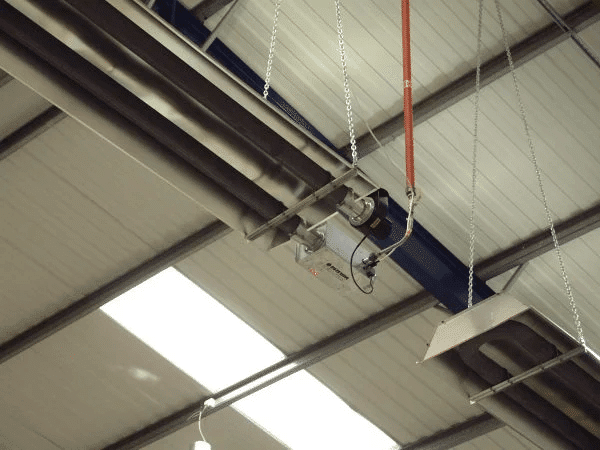What is radiant heat?
Whilst many heating systems rely on circulating warm air, radiant heating uses infrared heat energy. This is emitted in waves from a hot element such as ceiling mounted panel or underfloor pipes. And upon contact with surfaces or people, heat is produced and absorbed. As such, radiant heat provides more targeted and even heat distribution, rather than focusing solely on warming the air. This means workspaces can be warmed up in just a few minutes.
Additionally, less heat is lost to air escaping through doors, windows and uninsulated walls and ceilings – a common issue in warehouses. Plus, solid objects radiate some heat back into the room as they warm up, creating a secondary transfer of heat.
Radiant heating systems: two main types
Electric radiant heating
The first option is metal panels with coils that heat up when electricity runs through them. These can be mounted on walls or ceilings to warm particular zones quickly. For example, you may install panels above work stations to keep staff warm. Or, if there are obstacles that prevent you from using this option, you could fit an underfloor electric radiant heat system instead. In this case, electric cables or heating mats are placed inside the air space beneath your floor. This will heat the area you’re standing on, though it does use more energy to do so.
Hydronic radiant heat systems
Alternatively, you could go for a hydronic radiant heating system which uses hot water. A pipe network is installed overhead, beneath your flooring or ideally, embedded into it as it’s being built. Hot water is then circulated through the system to provide warmth from the bottom up. These systems are usually more energy-efficient than electric ones, especially when it comes to underfloor heating. But you’ll need to install a boiler and there’s the potential for leaks too.
Where are radiant heating systems most useful?
Radiant heating is a great solution for large open spaces that are hard to heat. This includes those with high roofs, a lack of insulation or significant draughtiness. For instance, where there are loading docks or frequently opened doors that allow warm air to escape. Radiant systems are also good for work areas which must be well ventilated because of the paints, solvents or other chemicals being used. Common applications include business premises like factories and other industrial plants, warehouses, garden centres, garages, workshops and sports halls.
Benefits of choosing radiant heating for your business
Targeted heat zones
To get the most out of your radiant heat source and keep costs down, we’d suggest using wall or ceiling mounted panels. Place them above or beside highly frequented spots, like work benches and packing areas, to keep your team comfortable. Radiant panels are also effective when doors or shutters are open, since the heat is concentrated and doesn’t rely on warm air. Plus, they’re safer than space heaters which can pose a trip or fire hazard in certain areas.
Good energy efficiency
As the thermal energy produced transfers directly to people and surfaces, less heat is wasted. You also only need to heat certain areas, rather than trying to warm up the entire space. That way, you won’t lose out on heating air only for it to rise or escape. Radiant heat panels also warm up faster than warm air heaters and offer more consistent heat with fewer cold spots. Likewise, they are more effective than space heaters and cheaper to run, particularly when fitted with a thermostat and timer. That way, you can set them to turn on as and when needed.
Doesn’t impact air quality
Another benefit of installing radiant heating is that it doesn’t blow air around and potentially spread allergens or pollutants. This makes it a good option for car garages, industrial plants and manufacturing spaces, where the transfer of chemicals and other irritants could pose a health risk. Similarly, radiant heat panels can be positioned near entranceways without the risk of stirring up dust and debris. Perfect if your business has a revolving door, for example.
Discreet and flexible design
Better still, if you want a heating system that will take up minimal space and won’t impact your interior design, you’re in the right place. Radiant floor heating can be hidden beneath your flooring so it’s completely out of view. Otherwise, mounted heat panels are typically sleek and discreet thanks to their virtually flat design – a bit like panel lights. These can be fixed to walls or ceilings, and as there are no moving parts involved, they are essentially silent. Plus, if you choose an electric system rather than hydronic, you’ll only have to run cables instead of pipes.
Commercial radiant heating installers in the North West
Whether you’d prefer radiant floor heating or strategically placed ceiling panels that emit heat from above, Atmostherm has you covered. Our commercial heating engineers can install efficient electric and hydronic radiant systems for businesses of all sizes throughout the North West. These can be specified for oil, gas or LPG boilers as required. We can also provide energy saving black bulb thermostats to give you more control over your system’s running costs. Learn more about our radiant heating services here or give our team a call on 0800 085 7510 for tailored advice.




